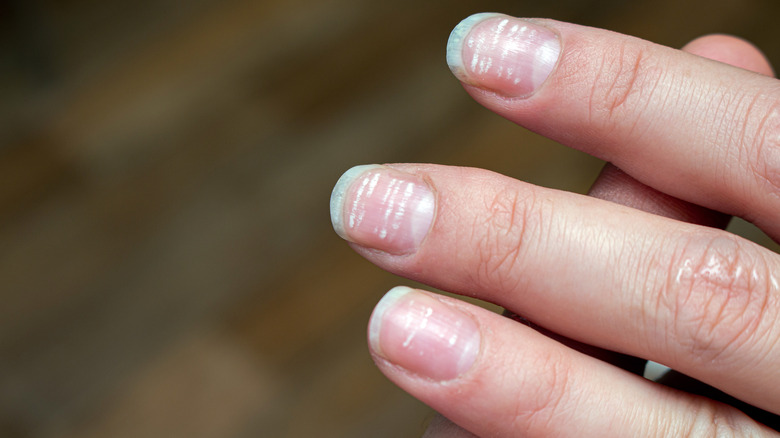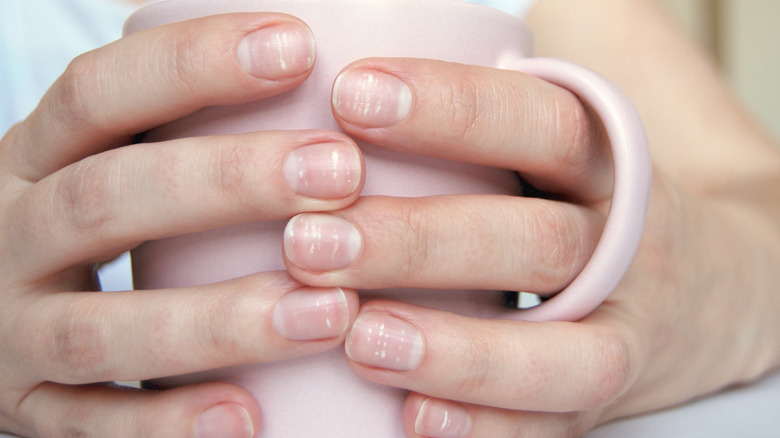Here's What Those White Spots On Your Nails Mean & How You Can Prevent Them
Although the skin, hair, and nails are all part of the integumentary system that makes up the outer layer of the body, nails tend to be the part that gets the least attention and care. It's often forgotten that the function of nails extends beyond the realm of aesthetics. According to Thompson Rivers University, fingernails and toenails serve to protect the soft tissues of the fingers and the toes against potential trauma and injury, in addition to improving sensation and fine motor control. Neglected nails can harbor dirt and bacteria, which can potentially lead to nail inflammation and skin infection.
It's no exaggeration to say that our nails are a reflection of our overall health. Changes in the texture or color of the nails can be a result of improper nail care, trauma, a fungus infection, or a serious condition in the body. For instance, nails with a black tinge can be an indicator of melanoma, while yellow nails can be a sign of thyroid disease or cancer (via Cleveland Clinic). White spots on the nail plates are another abnormal sign on the nail plates that shouldn't be brushed aside. If you're seeing white spots on your nails, here's what it means and how you can manage them.
Causes of white spots on nails
The most likely explanation for white patches on the nails is nail trauma. "When white spots are located within the nail plate and cannot be scraped or removed easily, they are called punctate leukonychia and are due to trauma to the nail matrix aka the half-moon area where the nail grows from," explains dermatologist and nail specialist Dr. Dana Stern to InStyle. "These white marks will grow out as the nail grows and are especially common in children who are more trauma prone and also have much thinner, less protective nail plates."
Long-term usage of nail polish can also result in keratin granulations, which are characterized by white spots on the nails. When the outermost layers of nail cells are detached along with polish, keratin granulations can develop, producing white and rough patches on the nails. The good news is: they will go away over time as your nails continue growing. According to Dr. Stern, white superficial onychomycosis — a rare type of nail fungus — is a possible cause for the appearance of white streaks on the nails. "This chalky white appearance at the nail is due to a fungus that invades the superficial layers of the nail plate," explains Dr. Stern.
The presence of white streaks on the nails may also signify a medical issue. White streaks, also known as Muehrcke's nails, are typical in people with kidney failure, claims HealthMatch. Muehrcke's nails are caused when there is insufficient blood supply to the nail bed.
What to do with white spots on the nails
If your nail picks up a white tinge as a result of trauma, you'll have to wait it out. If the spots are caused by keratin granulations, Dr. Stern advises lightly buffing the nail surface, treating it with a moisturizing oil or Vaseline, and refraining from using nail polish.
With white spots caused by prolonged nail polish wear, Emma Eskander, salon director of Gilded Ritual, recommends choosing nail polishes independent of potentially hazardous ingredients, such as polishes with formulations that are classified as "7-free" or higher. "This means that they are free of seven (or more) of the top toxic chemicals found in most traditional nail polishes," Eskander tells InStyle. Eskander also advises against being too abrasive to your nails or peeling off hard gel or nail enhancements the wrong way to avoid inflicting trauma on your nail bed. And, to protect the surface of your nail bed, always apply a base coat before layering with nail polish.
On the other hand, white patches brought on by fungus will need to be checked and treated by a dermatologist. You can pick up infections at salons that lack proper sterilization practices and trained technicians, so do your research thoroughly before going anywhere for a cosmetic beauty treatment. If white spots do not disappear after two to three months, Dr. Stern suggests you speak with a healthcare professional to find out whether they are an indication of a more serious medical condition.


